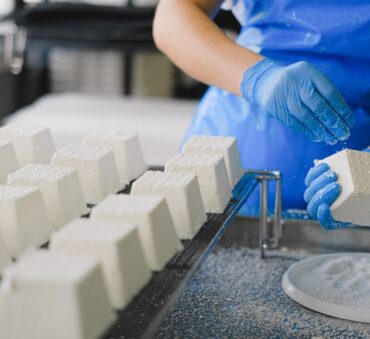From sanitizing machinery to the milk’s journey through pasteurization, water is an essential ingredient in dairy processing, but not all of it ends up in the final product. If you’ve ever wondered what happens to all the excess, you’ve come to the right blog. Let’s take a magnified look at dairy wastewater treatment in all its intricacies and implications, shall we?
Key Takeaways
- Why is Dairy Wastewater Treatment Needed: Dairy wastewater is a byproduct of milk processing that contains various contaminants. Proper treatment is essential for environmental protection and regulatory compliance.
- Benefits of Dairy Wastewater Treatment: Treating dairy wastewater offers multiple advantages, including operational savings, avoiding fines, and enhancing brand reputation. It also allows for the recovery of valuable byproducts like biogas and nutrients.
- Potential Products from Dairy Wastewater Reuse: Advanced treatment methods can turn dairy wastewater into a resource. Byproducts like biogas can be used as alternative energy sources, and recovered nutrients can be sold as agricultural fertilizers.
What is dairy wastewater treatment?
Dairy wastewater is a byproduct generated during the processing of milk and other dairy products. When milk is transformed into cheese, yogurt, or butter, water is used in various stages—cleaning, cooling, and even direct incorporation into the products. However, this water doesn’t exit the process as it entered; it becomes dairy wastewater. Laden with organic materials, chemicals, and residues. Therefore, it isn’t something you can simply pour back into nature without consequences to aquatic life and even human health.
However, the dairy industry faces a pressing issue. As consumer demand for dairy products rises, so does the production of wastewater. This creates an urgent need for effective waste management solutions that are both environmentally responsible and economically beneficial.
Fortunately, there have been some major shifts in treatment strategies that address these twin goals of environmental responsibility and profitability. We’ll cover these a little later.
What are the types of dairy wastewater?
Process Water
This is the water used directly in the production of dairy products. For instance, it’s used for cooling milk after pasteurization or for diluting ingredients. Process water becomes contaminated with various organic and inorganic substances, such as milk solids and minerals, making it unsuitable for immediate reuse or disposal.
Cleaning Water
Keeping a dairy facility clean is non-negotiable for maintaining product quality and safety. Cleaning water is used for washing equipment, storage tanks, and production areas. This water typically contains detergents, disinfectants, and other cleaning agents, along with the residues of milk and dairy products.
Sanitary Wastewater
This category includes wastewater from restrooms, handwashing stations, and other general sanitation facilities within the dairy plant. While it may not contain dairy residues, it does have its own set of contaminants, like soap, tissue paper, and human waste.
The Need for Dairy Wastewater Treatment
The treatment of dairy wastewater is not merely a technical aspect of dairy operations; it’s a critical business strategy with far-reaching implications.
Regulatory Compliance
Failure to comply with agricultural waste regulations, including wastewater, can result in substantial fines and legal challenges. More importantly, these regulations exist to safeguard public health and environmental integrity.
Brand Reputation
Today’s consumers are discerning, often seeking products that align with their ethical and environmental values. Effective wastewater treatment can serve as a cornerstone in a company’s sustainability strategy, enhancing its reputation and competitive edge.
Financial Viability
While the upfront costs of wastewater treatment systems may seem daunting, the long-term economic benefits are compelling. Advanced treatment technologies offer the potential for resource recovery, such as reusing water within the facility or recovering nutrients for agricultural use. This not only reduces operational costs but also turns a liability into an asset.
Characteristics of Dairy Wastewater
Dairy wastewater is far from being just “dirty water.” It’s a complex mixture containing various contaminants, each with its own set of challenges and opportunities for resource recovery.
Primary Contaminants and Their Potential Value
- Organic Matter: Includes milk solids and fats that can lead to water pollution if untreated. However, these organic food waste can be converted into biogas through anaerobic digestion.
- Chemicals: Detergents and sanitizers used in cleaning processes are common chemical contaminants. Some of these chemicals can be recovered and reused with the right treatment technologies.
- Nutrients: High levels of nitrogen and phosphorus are often present, posing risks to aquatic life. Interestingly, these nutrients can be recovered and used as fertilizers in agriculture.
- Minerals: Calcium and magnesium are often found in dairy wastewater. These minerals can be recovered and have applications in various industries, including agriculture and construction.
Seasonal Variations and Production Scale: Impact on Treatment Strategies
The characteristics of dairy wastewater can vary depending on the season and the scale of production. For example, during peak production seasons, the volume of wastewater generated will be higher, requiring more robust treatment solutions. Similarly, larger facilities may produce wastewater with different contaminant profiles compared to smaller operations, necessitating tailored treatment approaches.
Dairy Wastewater Management Options

Discharge to Sewer
This is often the most straightforward method, where wastewater is sent to a municipal facility. While this eliminates the need for on-site treatment, it comes with its own costs, both financial and environmental. However, the fees for sewer discharge can be substantial, and the wastewater still undergoes chemical treatment at the municipal facility, which has its own environmental footprint.
Discharge to Environment
Direct discharge into water bodies is another option, but it comes with stringent regulatory requirements. The wastewater must be treated to meet specific quality standards to ensure it doesn’t harm aquatic life or contribute to water pollution. This method often requires advanced on-site treatment systems and regular monitoring.
Reuse
Perhaps the most forward-thinking approach is the reuse of dairy wastewater, particularly for biofuel production. This provides an alternative energy source as well as significantly reduces the organic load of the wastewater, making further treatment easier and more cost-effective.
Dairy Wastewater Treatment Methods

Effective treatment of dairy wastewater involves a combination of primary and secondary methods, each designed to remove specific types of contaminants. Here’s a closer look at these methods:
Primary Treatment Methods
Screening: This is the initial step where large solid particles are removed from the wastewater. It’s a mechanical process that uses screens to filter out debris, ensuring smoother operation of subsequent stages.
Sedimentation: After screening, the wastewater is allowed to settle in a tank. Gravity pulls down heavier particles, separating them from the water. This process is particularly effective for removing suspended solids and some types of organic matter.
Chemical Coagulation: Chemical agents are added to the wastewater to induce the formation of larger particles from smaller contaminants. These larger particles are then easier to remove through sedimentation or filtration.
Secondary Treatment Methods
Activated Sludge Process: This biological treatment involves aerating the wastewater to encourage the growth of beneficial microorganisms. These microbes consume organic matter, effectively reducing the wastewater’s pollutant load.
Anaerobic Digestion: In an oxygen-free environment, specific bacteria break down organic matter into simpler substances. This method is especially useful for high-strength dairy wastewater and has the added benefit of producing biogas that can be used as an energy source.
Membrane Filtration: This advanced method uses semi-permeable membranes to separate finer particles and contaminants from the water. It’s highly effective but can be more costly compared to other methods.
Oxidation Ponds: These are man-made water bodies where wastewater is treated through natural processes like sunlight, algae growth, and microbial action. While less efficient than other methods, they are easier to maintain and are often used in smaller facilities.
Sustainable and Innovative Treatment Methods
Breaking away from traditional paradigms, the dairy industry is embracing more biological treatments of dairy wastewater that challenge our conventional understanding of wastewater treatment, offering more than just purification—these are solutions that could redefine the industry’s approach to waste management.
Constructed Wetlands
This method mimics natural wetlands to improve water quality. Constructed wetlands are engineered systems where wetland plants and microbes work in tandem to remove contaminants. They are particularly effective for treating wastewater rich in nutrients and organic matter, offering a low-cost and low-maintenance solution.
Algal Treatment Systems
Algae are more than just pond scum; they’re tiny environmental heroes. In algal treatment systems, specific strains of algae are cultivated to absorb nutrients and organic matter from wastewater. This method is still in its experimental stages but shows promise for both nutrient removal and biomass production, which can be used for biofuel.
Biochar and Activated Carbon Filtration
Biochar and activated carbon are carbon-rich materials that excel at adsorbing contaminants. When used in filtration systems, they can effectively remove a wide range of pollutants, from organic matter to heavy metals. These materials are reusable, making this method both effective and sustainable.
Financial Benefits of Dairy Wastewater Treatment
The advantages of treating dairy wastewater extend beyond environmental stewardship and regulatory compliance. There are tangible financial benefits that make wastewater treatment a compelling investment for dairy operations.
Operational Savings
Treating wastewater on-site can significantly reduce costs associated with waste disposal and water usage. Advanced treatment systems can purify wastewater to a level where it can be reused in the facility, cutting down on the need to purchase fresh water. This leads to a cycle of savings that positively impacts the bottom line.
Avoid Fines
The regulations surrounding wastewater disposal are stringent, and for good reason. Failure to comply can result in substantial fines that can cripple a business financially.
Earn from Byproducts
Wastewater treatment isn’t just about eliminating waste; it’s also about resource recovery, such as we discussed earlier with anaerobic digestion and biogas. Similarly, nutrients like nitrogen and phosphorus can be recovered and sold as agricultural fertilizers, adding a revenue stream to the wastewater treatment process.
Equipment Lasts Longer
Untreated wastewater contains contaminants that can be corrosive or damaging to machinery. By treating this water, you extend the lifespan of your equipment, reducing the frequency and cost of repairs or replacements. This is an often-overlooked financial benefit that adds to the long-term viability of your dairy operation.
Conclusion
Wastewater treatment in the dairy sector is a critical component that offers multiple advantages, both environmentally and financially. The array of treatment methods available today are both effective and increasingly aligned with sustainability goals. These benefits are not just about compliance or operational efficiency; they also extend to financial gains, such as reduced costs and potential revenue streams.
If you’re in need of specialized liquid waste disposal or dairy waste management services, Shapiro is here to assist. Contact us to discuss customized solutions that can enhance your dairy operation’s wastewater management.
Baily Ramsey, an accomplished marketing specialist, brings a unique blend of anthropological insight and marketing finesse to the digital landscape. Specializing in educational content creation, she creates content for various industries, with a particular interest in environmental initiatives.



